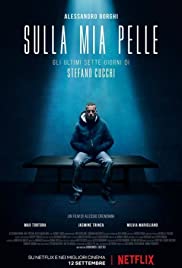
SULLA MIA PELLE/ON MY SKIN
Italy, 2018, 100 minutes, Colour.
Alessandro, Borghi, Massimiliano Tortora, Jasmine Trinca, Milvia Marigliano.
Directed by Alessio Cremonini.
Watching this film makes great demands on its audience. It is quite harrowing. Its subtitle: The Last Seven Days of Stefano Cucchi.
The film is based on a true story, an episode of a 31-year-old surveyor, user of drugs, previous addict and in rehab, who works with his father in his surveying firm. His parents have bought him an apartment so that he can be independent. He has a married sister with children. The film shows him with drugs, especially hash, the visit to his parents and a meal with them.
The film also shows from then on specific times and specific places, Stefano talking with his friend in a car, the Carabinieri getting them out of the car, searching them, suspicious and critical, finding the small amount of drugs, arrest. There is great detail in showing how the police treat Stefano, not just the uniformed men but two men out of uniform joining them. Stefano has bruises on his face – but the film does not show any of the scenes of his being bashed, the reality emerging as the audience sees his face, then bruises on his body and back, broken vertebrae, a series of x-rays.
At the beginning, it is shown that Stefan is dead in the hospital. The action goes back a week, building up his week in custody, in the court, remanded for a month, ill and in pain, unwilling to eat, to take medication except for his epilepsy (which takes a long time to come), eventually needing a catheter. His move to different precincts, to different hospitals.
The film also shows his mother and father, their concern, the angry daughter, their attempts to visit, bureaucracy and the demands of authorisations and not communicating who supplied the authorisations. To that extent, the film is frustrating for the audience who identify also with the parents. It is only when he is dead, and again with difficulties about authorisations, that they eventually see their son.
At the end of the film, there are verbal excerpts from Stefano and his trial as well as frightening statistics of how many prisoners die in custody.
• The story, Stefano Cucchi, his life, drugs, the arrest, the treatment by the Carabinieri, the violence
.
• A portrait of Stefano, his age, growing up, relationship with his parents, working for his father, a surveyor, his friends, the previous drug addictions, rehab, lying to his parents, his stash in is apartment, the parents buying him this independence. His visit to his parents. Clashes with his sister. Friendship with her husband.
• The night, sitting in the car, the small amount of drugs, police suspicion.
• The behaviour of the police, suspicions, administering the law, the two out of the car, searched, the attitudes of the police and their speeches, the arrest.
• The fact that Stefano was beaten, the bruises on his face, the revelation of the bruises on his body, the pain in his back, the vertebrae broken.
• The fact that this was not seen by the audience, only the verbal descriptions in the visuals of the cuts and bruises.
• The indications of times and places, the audience immersed in Stefano’s experience.
• The various locations, offices, police precincts, Regina Coeli prison, hospital, hospital prison?
• The behaviour of the authorities, wanting authorisations, the abrupt and official and answer to enquiries.
• Stefano’s experience, saying he fell down the stairs, not wanting to antagonise the Carabinieri with its consequences? His speeches for the doctors, but confiding in more sympathetic listeners, Marco, the fellow prisoner.
• The week passing, the long sequences with his mother and father, his father going to the court, seeing his son, the bruises, not wanting to antagonise the Carabinieri? The mother, upset? The visit to the hospital, not being admitted, the information about the authorisation, the return visit, that they should have had the authorisation? Stefano her sister, her angry actions, phone calls to the lawyer? The three eventually coming to hospital.
• The doctors, the nursing staff, the paramedics, Stefano and rejecting them in the cell, treatment in the hospital, the range of x-rays, medications, the fact of his epilepsy, wanting his epilepsy tablets, his being deprived, eventually receiving them.
• The cumulative effect of the bashing, the vertebrae, the aches in his back, internal difficulties, the catheter, his not wanting to eat, refusing the fluids. Then wanting the chocolate but it’s not being there.
• The audience knowing that he had died, the opening sequence, the week passing, the repetition of the sequence, the attempts to revive him.
• The official, visiting his mother, the formalities of the information, the document, the news of Stefano’s death, communicating with her husband, the reaction of their daughter.
• The autopsy, going to the morgue, the officials refusing, the authorisations, the daughter standing her ground, going to see their dead son.
• The information about the case, the investigations, hearings, the defendants released, further investigation, guilty findings.
• The effect of this kind of harrowing cinema experience, response to authorities and authoritarianism, authorities and the use of violence, the effect on the ordinary citizen, bewilderment is how to respond to authority, care and negligence, death in custody and the statistics given for the high number.